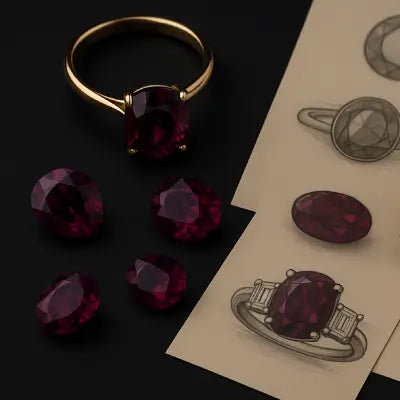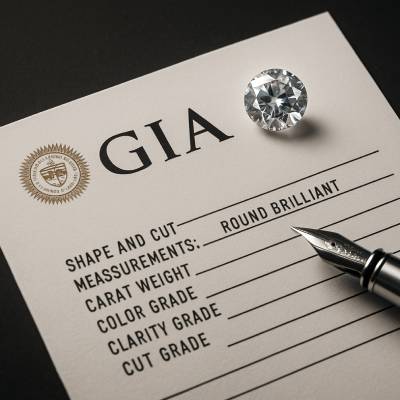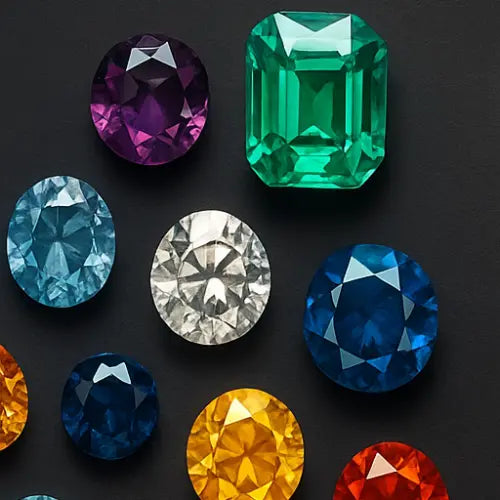Introduction to Custom Pendants
A custom pendant is a unique expression of your personal style. It is specifically designed to match an individual's taste and style. Unlike mass-produced items, custom pendants are tailored to the wearer's preferences. This makes them unique and personal. The meaning of creating individualized jewelry lies in its sentimental value. It often symbolizes a special memory, a significant milestone, or a meaningful relationship.
Understanding how to make a pendant involves a few essential steps. Initially, the designer collaborates with the client to conceptualize the design. It incorporates personal touches and preferences. Next, a detailed sketch or digital model is generally created. The manufacturing process may include metalworking, gem setting, and engraving. This is critical once the design is approved. Finally, the pendant is polished and finished to perfection. Custom pendants offer a unique blend of artistry and personal expression. They make them cherished keepsakes that resonate with the wearer's identity and experiences. Let's dive into the details.
Designing Your Custom Pendant
Now, let's delve into the fascinating process of designing your custom pendant. Check the information below:
- Inspiration and Ideas: This is the first step in creating your custom pendant. Start by looking at existing pieces to identify styles and elements you like. Consider personal symbols. They may be initials, zodiac signs, or meaningful shapes that resonate with you. Nature, art, and architecture can also provide unique custom pendant ideas. Reflect on personal experiences and relationships to incorporate themes that hold sentimental value.
- Sketching Your Design: This step is crucial. Begin with rough sketches to explore different concepts and layouts. This helps visualize the design and refine details. Experiment with various elements and combinations until you find a perfect design. Remember, the initial sketches don’t need to be perfect. They are a tool to communicate your vision to a designer or jeweler.
- Choosing the Right Shape and Size: This aspect is vital in how to make a gold pendant. It significantly impacts its look and wearability. Consider the purpose of the pendant. Is it for everyday wear or special occasions? A smaller, simpler design might be more practical for everyday use. A larger, more intricate piece could be suitable for special events. The pendant’s shape should complement the design elements. It may fit comfortably with the chain or necklace it will hang on. Consider how the pendant will sit against the skin. Coordinate with other jewelry pieces you wear.
Understanding how to make a pendant and integrating personal elements into your design is vital. So you can create a custom piece that is both beautiful and meaningful.
Selecting Materials
This is a crucial aspect. Let’s discuss all specifics:
- Metal Choices: When designing custom pendants, selecting the right metal is crucial. Gold is available in yellow, white, and rose varieties. This is popular for its timeless appeal and versatility. Silver offers a classic, elegant look and is more affordable. It may require more maintenance to prevent tarnishing. Platinum is famous for its durability and luxurious feel. It makes it a premium choice despite its higher cost.
- Gemstones and Inlays: Incorporating them can add a unique touch to your pendant. For custom pendant ideas, consider diamonds for their brilliance and classic charm. Colored gemstones like sapphires, emeralds, and rubies provide a vibrant pop of color. Birthstones add a personal touch. Enamel inlays can bring artistic elements and vivid colors. Materials like mother-of-pearl or wood offer unique textures and aesthetics.
- Balancing Aesthetics and Durability: Choose materials that are beautiful and solid. Gold and platinum are excellent choices for their lasting beauty and resilience. Silver, while elegant, needs more care to maintain its shine. When adding gemstones, consider their hardness and how securely they are set. Ensure they can withstand daily wear. Balance aesthetics and durability. So, you can create a stunning and wearable pendant for years to come.
Understanding how to make custom pendants and thoughtfully selected materials is crucial. So, you can create a beautiful, durable piece that reflects your style and preferences.
Working with a Jeweler
Now we will explore this crucial point. Here is a detailed exploration:
- Finding a Reputable Jeweler: Select a skilled jeweler. Start by researching jewelers with a strong reputation for custom work. Look for reviews and testimonials from previous clients. Gauge their experience and satisfaction. Visit the jeweler’s website or portfolio to view examples of their custom designs. Ensure they have expertise in the materials and techniques you’re interested in. Personal recommendations can also be valuable, so ask friends or family for referrals.
- Consultation Process: During the consultation, discuss your design ideas, preferred materials, and budget. Be prepared to share your inspiration and any sketches or images that convey your vision. The jeweler will provide professional input on how to make your own pendant. He will suggest feasible design adjustments and material choices. They will enhance durability and aesthetics. They will also explain the timeline for the project and provide an estimated cost. This is the time to ask questions and clarify doubts about the process. Ensure you and the jeweler clearly understand the expectations.
- Reviewing Mock-ups and Prototypes: This point is crucial. Do it before finalizing the best custom pendants design. The jeweler may create digital renderings or physical prototypes of your pendant. This step allows you to visualize the final piece and make necessary adjustments. Pay close attention to details. They are the size, shape, and placement of gemstones or inlays. Provide feedback at this stage. It ensures that the final product aligns with your vision and expectations.
Understanding how to make custom pendants involves critical elements. They are collaboration and clear communication with a reputable jeweler. Carefully select your jeweler, engaging thoroughly in the consultation process. Also, meticulously reviewed prototypes. So you can create a stunning, personalized pendant. It will reflect your unique style and preferences.

Custom Pendant Ideas
Inspiration is all that you need. We have prepared some custom pendant ideas. Here are they:
- Personalized Engravings: Adding them is a beautiful way to create pendants. Consider engraving names, dates, or meaningful quotes that hold sentimental value. Names and initials of loved ones can create a connection to family or significant others. Dates mark special occasions like anniversaries, birthdays, or achievements. They can make the pendant a cherished keepsake.
- Incorporating Family Heirlooms: Incorporate elements from heritage into your pendant design. It can create a unique piece that carries deep sentimental value. If you have an old piece of jewelry, you can repurpose its gemstones, metal, or design elements into a new pendant. It may be such as a brooch, ring, or necklace. This honors family history and breathes new life into treasured items. Discuss with your jeweler how to make your own pendant using these heirloom pieces.
- Unique Design Elements: They can separate your custom pendant. Intricate filigree or latticework, can add elegance and complexity to the design. Consider using mixed metals, like combining gold and silver. Create a striking contrast and modern look. Unconventional shapes are asymmetrical designs, geometric forms, or nature-inspired motifs.
Creating the best custom pendants involves several key considerations. They are a blend of personal touches and creative design choices. Incorporate personalized engravings, family heirlooms, and unique design elements.
Creating the Pendant
This is a complex process. It consists of 3 important stages. Let's look at them in more detail:
-
Crafting the Base: This process begins with designing and creating a model. A wax model is often carved or 3D-printed for a custom platinum pendant based on the final design. This model is then used to create a mold. The chosen metal is generally melted and poured into the mold in a casting process. Once cooled, its form is meticulously removed from the mold. It undergoes shaping and refining. Jewelers trim, file, and smooth the metal to achieve the desired shape and detail.
- Adding Finishing Touches: This final step also adds additional details. Polishing the metal gives it a smooth, shiny finish. It enhances its beauty and appeal. Engraving personal messages, names, or dates can add sentimental value and uniqueness. Additional details are intricate patterns or mixed metal accents. They add to ensure the pendant meets the client’s vision. These finishing touches transform a simple piece of metal and gemstones. It has become one of the best custom pendants. They showcase exceptional craftsmanship and personal significance.
- Setting Gemstones: This is a delicate process requiring skill and precision. It helps to ensure the stones are secure and prominently displayed. The Prong, bezel, or pave settings are always used depending on the design. In prong settings, small metal claws hold the gemstone. They maximize light entry and enhance the stone’s sparkle. Bezel settings encase the gemstone with a thin metal rim. They offer a sleek and secure hold.
Understanding these steps ensures a beautiful piece. It will be uniquely yours.
Attaching the Pendant to a Chain
Let’s explore how to get a pendant on a chain. This is a complex process. Here are all details:
- Choosing the Right Chain: Select the appropriate one for your pendant. This is crucial for aesthetics and functionality. Consider the length of the chain. Longer ones create a more relaxed look. Shorter chains offer a classic style. The style should complement the pendant design. Thicker chains can balance larger pendants. Delicate chains work well with more intricate or smaller designs. Ensure that the metal matches the pendant material for a cohesive look. It’s gold, silver, or a custom platinum pendant.
- Securing the Pendant: Proper attachment to the chain ensures the pendant stays secure. Most pendants feature a bail, a small loop that fits over the chain. Make sure the bail is sturdy enough to support the pendant’s weight. If the pendant lacks bail, you can work with a jeweler to create one or use a jump ring. It’s important to close the bail or ring tightly to prevent the pendant from slipping off. Testing the pendant on the chain before wearing it can help confirm that it is secure.
- Customizing the Chain: This aspect is essential in how to make a medallion necklace. It can enhance your necklace's uniqueness. Consider adding additional charms that resonate with you or hold special significance. You can adjust the length for a personalized fit, whether you prefer a choker style or a longer drop. Combine many chains of varying lengths and styles to create a layered look. It can add depth and interest to your overall design.
Understanding how to get a pendant on a chain and selecting components is vital. So you can create a stunning medallion necklace that showcases your style beautifully. This attention to detail is key. It ensures that your piece remains a cherished part of your jewelry collection for years.
Caring for Your Custom Pendant
This is a crucial aspect. You must know all the essential tips. So your accessories will be in perfect condition. Here are the maintenance rules:
- Cleaning and Maintenance: Use a soft, lint-free cloth. Wipe the surface, removing dirt and oils gently. For deeper cleaning, create a mild solution of warm water and gentle soap. Soak the pendant briefly. Use a soft brush to clean hard-to-reach areas. Avoid harsh chemicals or abrasive materials. They can damage the metal or gemstones. Knowing how to make a pendant necklace is just the beginning. Maintaining its pristine appearance is crucial to showcase its unique design.
- Proper Storage: Proper storage is key to preventing damage and tangling. Store your pendant in a soft pouch or a dedicated jewelry box lined with fabric. Avoid placing it in direct contact with other jewelry pieces to minimize scratches. If possible, hang the pendant on a dedicated hook or a necklace organizer. Keep it untangled and protected.
- Regular Inspections: Regular inspections are important for identifying any potential issues. Periodically check for loose stones or signs of wear, such as scratches or tarnishing. Addressing these concerns early can prevent more significant repairs later on. If you notice any issues, consult a professional jeweler for repair options.
By understanding how to make a gold pendant and implementing these care tips, you can ensure your custom piece remains a cherished part of your collection for years. Taking proactive cleaning, storage, and inspection steps. They will keep your pendant beautiful and lasting.






